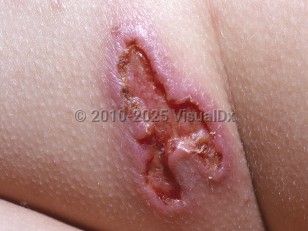Acute lymphoid leukemia in Adult
Alerts and Notices
Important News & Links
Synopsis

Acute lymphoid leukemia can present emergently and require consultation with an oncologist. Leukostasis in the setting of hyperleukocytosis with WBC > 200-400 × 109 can present with neurologic (stroke or intracranial hemorrhage) and/or pulmonary (hypoxia) complications, necessitating rapid cytoreduction, commonly with steroids with or without early initiation of chemotherapy. Tumor lysis syndrome and disseminated intravascular coagulation (DIC) are other potential critical complications of acute lymphoblastic leukemia and warrant urgent evaluation and management.
Diagnosis Overview:
Acute lymphoblastic leukemia (ALL) / lymphoblastic lymphoma (LBL), also known as acute lymphocytic leukemia / lymphoma or acute lymphoid leukemia, is a cancer of precursor B cell, T cell, or other cell types in which immature lymphoid cells accumulate in blood, bone marrow, or other tissue.
Diagnosis usually requires the presence of over 20% lymphoblasts in the peripheral blood and/or the presence of bone marrow or tissue infiltrate of immature cells with confirmation of lymphoid lineage by flow cytometry and/or cytochemistry.
ALL / LBL is the most common cancer in children (mostly younger than 6 years and accounting for a quarter of all childhood malignancies) and is also seen in adults (usually older than 60 years). Children may present with unexplained fevers, pallor, hepatosplenomegaly, lymphadenopathy, and/or bleeding and easy bruising. Retinal hemorrhage may occur. The cause of ALL / LBL is unknown, but it has been associated with ionizing radiation as well as certain genetic abnormalities. Approximately 75% of infants with ALL have KMT2A gene rearrangement (formerly known as mixed-lineage leukemia), associated with particularly poor outcomes. The Philadelphia chromosome (Ph), while rare in childhood cases of ALL, is present in 20%-25% of adult cases, the most common genetic subgroup. The incidence of Ph-positive ALL increases with age.
Codes
C91.00 – Acute lymphoblastic leukemia not having achieved remission
SNOMEDCT:
91857003 – Acute lymphoid leukemia, disease
Look For
Subscription Required
Diagnostic Pearls
Subscription Required
Differential Diagnosis & Pitfalls

Subscription Required
Best Tests
Subscription Required
Management Pearls
Subscription Required
Therapy
Subscription Required
Drug Reaction Data
Subscription Required
References
Subscription Required
Last Updated:07/24/2025

